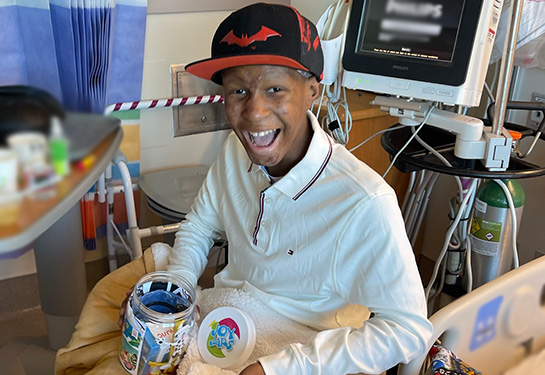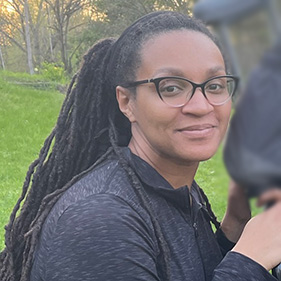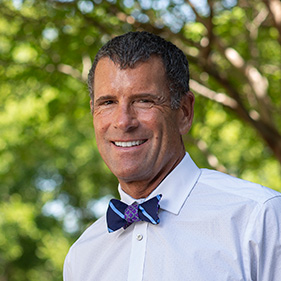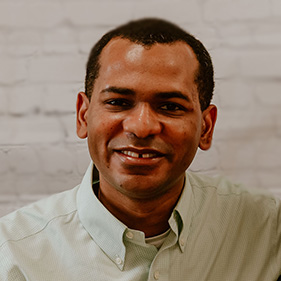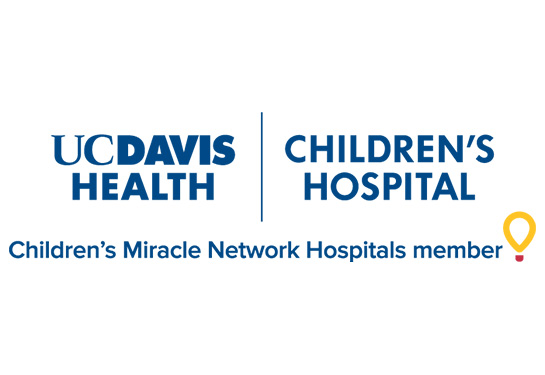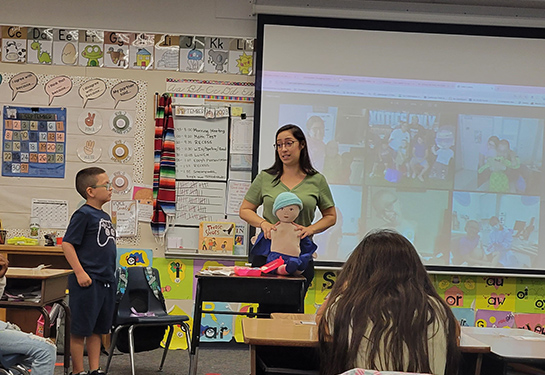Michigan boy’s life and limb saved by UC Davis care team
Osteosarcoma meant 11-year-old boy would likely lose his leg. But his family sought hope and another opinion.
A pulled muscle, growing pains, a sprain. These are what most parents think of when their child says their leg hurts. But for Karen and Baron Colbert, it was unusual to hear their son Darren say he was in pain.
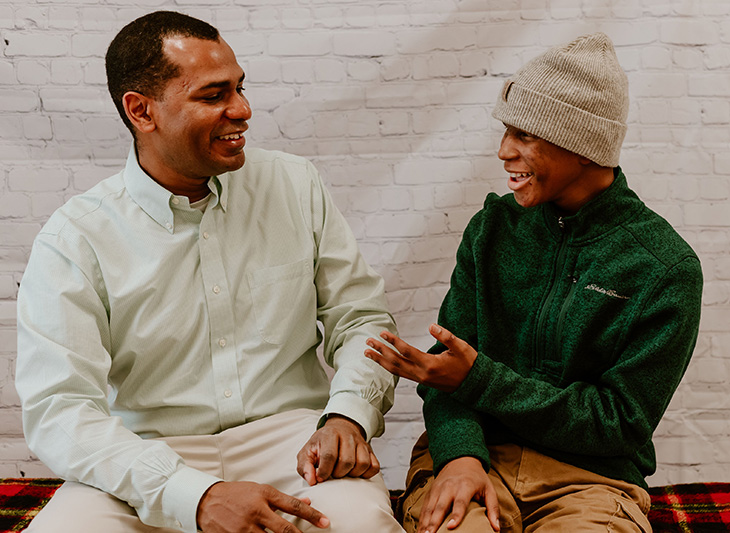
As the fourth of their nine children — all with names that rhyme with their parents — Darren was an active kid who loved sports, swimming and going to the gym. It was just not like him to complain, but he told his parents his left thigh really hurt.
Karen Colbert took her son to a clinic in Michigan where they live. It was late February 2022.
During the exam, the doctor touched Darren’s leg here and there, asking if it hurt. His mom vividly recalls that when the doctor squeezed a part of Darren’s leg that caused him obvious pain, the doctor spun around and asked her, “Are you in a hurry?”
“To this day, I will never forget the look he gave me,” Colbert said.
Despairing the future: What now?
The journey from the pediatric clinic room to the X-ray suite happened in slow motion. It was then that Darren’s mom began to think something was really wrong.
She was right. The X-rays revealed a growth in Darren’s leg. Karen called her husband.
Baron Colbert was stuck in a snowstorm in Chicago. “It was hard not to be there, especially because we had no idea what we were facing,” he said.
“I thought they had made a mistake,” his mom added. “I just kept playing that over and over in my mind that they were going to tell me that it wasn’t what they thought it was: cancer.”
Preparing for the worst: Osteosarcoma
The family was referred to several Michigan hospitals that had oncology and orthopaedic teams. The family chose to go to Grand Rapids. The countdown had begun. It would be six weeks until Darren’s appointment. The wait was excruciating.
When the time came, the Colberts loaded up their nine kids and made the nine-hour drive. Darren’s parents met with the care team and were told that they, too, suspected Darren had cancer, but they would need a biopsy to confirm.

Further tests revealed that Darren had osteosarcoma, a type of sarcoma, or cancer, that begins in the cells that form bones. Most osteosarcomas occur in children, teens and young adults. Darren was 11 years old.
With chemotherapy and a bone replacement surgery, Darren could survive and thrive, the care team told them. The Colberts were thrilled. They had caught it in time. It was going to be like it never happened, they told themselves. He’s going to grow up, grow tall.
When Darren started chemotherapy, the family breathed a sigh of relief. But two rounds of treatment later, Darren’s tumor began to hemorrhage, or bleed. He was taken to the local emergency room near their home and stabilized. Then the family made arrangements for the nine-hour trip back to the hospital where Darren’s cancer care team was located.
Comparing medical opinions: Amputation, or was there another option?
“They told us the bleeding meant Darren was no longer a candidate for a bone replacement because the hemorrhage had contaminated his leg,” Baron Colbert said. “That’s when the long-term prognosis changed, and they started talking about amputation.”
The tumor was in an area of the leg that would require the entire left leg to be removed at the hip.
“There were so many options to begin with and then everything was taken off the table,” Karen Colbert said. “We didn’t want to believe that amputation was the only answer and that was all they were offering. We wanted a second opinion.”
There were so many options to begin with and then everything was taken off the table. We didn’t want to believe that amputation was the only answer and that was all they were offering. We wanted a second opinion.” —Karen Colbert, Darren’s mom
Darren’s parents sought a second opinion but got the same answer. That’s when they turned to 2nd MD, a service that connects families with board-certified, leading doctors across the country for an expert second opinion via video or phone. Through 2nd MD, the Colbert family was introduced to R. Lor Randall at UC Davis Children’s Hospital.
“We asked Dr. Randall if there was another way,” Karen Colbert said. “We didn’t want to see our son become an amputee if there was something else that could be done.”
Caring: More than just statistics and treatment
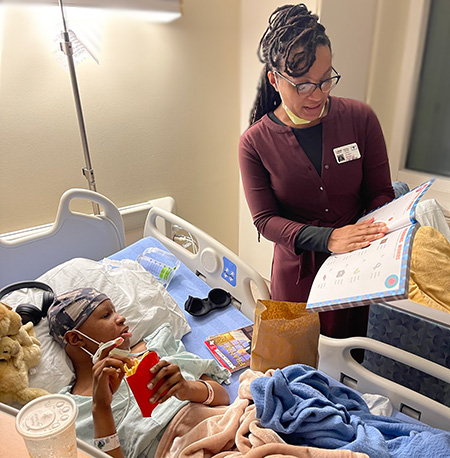
Lor Randall specializes in orthopaedic surgery and pediatric oncology, the perfect combination of expertise for Darren’s illness. Not only did Randall’s training fit the bill, so did his compassion.
“Dr. Randall read Darren’s records and recognized what a psychological blow it would be to our 11-year-old son if he lost his leg,” Baron Colbert said. “It was the opposite of what I expected to hear.”
“In listening and learning from Darren’s parents, we started the conversation acknowledging the horror of their journey thus far and their fears for Darren’s life,” Randall said. “We then talked about how best to remove the cancer surgically, weighing the risk of limb salvage with amputation.”
Karen Colbert added, “He was the first person who put Darren first. He didn’t talk to us about stats,” she said. “Dr. Randall brought the humanity back to what a family battling cancer looks like. To me, that was the most important part.”
In listening and learning from Darren’s parents, we started the conversation acknowledging the horror of their journey thus far and their fears for Darren’s life. We then talked about how best to remove the cancer surgically, weighing the risk of limb salvage with amputation.”—R. Lor Randall, orthopaedic surgeon and pediatric oncologist
Daring to save life … and limb
Now that Randall had suggested surgery was possible, the family had renewed hope. Perhaps Darren could have surgery and still keep his leg, an outcome the Colberts desperately wanted. Randall passed his notes on to Darren’s care team in Michigan.
As their son’s chemotherapy continued and the MRIs began to show that the tumor was shrinking, the Colberts kept in touch with Randall. Although Randall felt confident Darren’s leg could be saved, Darren’s Grand Rapids care team felt amputation was still the best option. They were not comfortable doing anything else.
The family flew to Sacramento for a consultation. Randall and the UC Davis Children’s Hospital team shared the risks with Karen, Baron and Darren, including the fact that the team would not know whether they could save Darren’s leg until they were in the operating room.
“He not only made us feel confident, he made us feel comfortable,” Karen Colbert added. “We definitely wouldn’t be here without him.”
The Colberts decided to put their faith in Randall to perform what they hoped would be a lifesaving, limb salvage surgery. The procedure took place during that same visit to California. Everyone on Darren’s care teams in Grand Rapids and Sacramento was rooting for him.

“In Darren’s case, the surgical challenge was that the tumor had bled onto critical blood vessels. Accordingly, we would have to dissect the outer layer of the vessels for a long distance to get an adequate surgical margin on the cancer [to get it all out],” Randall said. “Because his leg had to grow [lengthen] in the future, he was not a candidate for vascular grafting.”
“It was the longest day of our lives,” said Baron Colbert of September 14, 2022, when Darren finally had surgery at UC Davis Children’s Surgery Center. “It was a delicate operation with huge risks, including the fact that the tumor was starting to close in on his femoral artery.”
The femoral artery is the main blood vessel supplying blood to the lower body. It starts in the upper thigh near the groin and runs down to the back of the knee. The mass in Darren’s leg was within two millimeters of the femoral artery.
The surgery took 11 hours. The Colberts had updates along the way and knew Darren made it through. But they wanted to hear directly from Randall.
Were there complications? Could Randall remove the whole tumor? Was Darren’s leg saved? So many questions. So many life-changing answers pending.
Declaring victory: California care team delivers
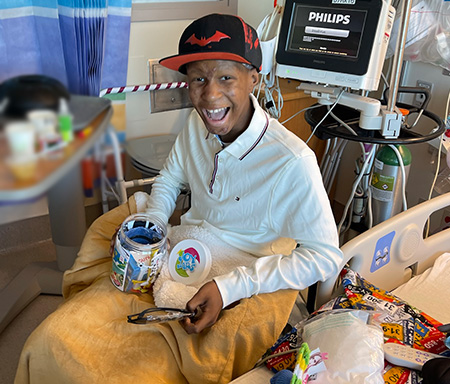
When the moment of truth arrived, Darren’s parents – far away from home and their other eight children who were back in Michigan – held their collective breath.
“Dr. Randall came out and told us the surgery had gone well. Nothing was damaged and the margins were good,” Baron Colbert said. “And then the moment of truth: He was able to save Darren’s leg. It was everything we had hoped for.”
“Personally, it was such a remarkable privilege to be able to deliver on their trust. The operation was a technical success,” Randall said. “Fortunately, the final pathology results showed all margins were free of cancer.”
Dr. Randall came out and told us the surgery had gone well. Nothing was damaged and the margins were good. And then the moment of truth: He was able to save Darren’s leg. It was everything we had hoped for.” —Baron Colbert, Darren’s dad
When Darren returned home to Michigan, he began intensive physical therapy to get him back on his feet, literally and figuratively. He continued chemotherapy treatments as his Michigan-based oncology team cheered him on.
“Everyone was on pins and needles as we waited for his next set of scans,” Colbert said. “They came back clear!”

This now sixth grader has completed treatment and is back to enjoying time outside and playing and learning alongside his brothers and sisters – Sharon, Taryn Lily, Baron II, twins Erynn and Aaron, Jarron, Terron Robert, and Zarron – ages 4 to 17. His parents are grateful their son is recovering and his leg is intact.
“To any family who starts a cancer journey like this, it can be scary to feel like you need a second opinion. But you need to feel supported and have someone who will put you and your family first,” Karen Colbert said. “We are so fortunate to have met Dr. Randall.”
“We are thankful to have had access to this level of care,” Baron Colbert said. “We think the world of Dr. Randall and his staff. Meeting him was life-changing.”
UC Davis Children's Hospital is the Sacramento region's only nationally ranked, comprehensive hospital providing care for infants, children, adolescents and young adults with primary, subspecialty and critical care. It includes the Central Valley's only pediatric emergency department and level I pediatric trauma center, which offers the highest level of care for its critically ill patients, as well as a level I children’s surgery center. The 129-bed children's hospital includes the state-of-the-art 49-bed neonatal and 24-bed pediatric intensive care and pediatric cardiac intensive care units. For more information, visit children.ucdavis.edu.

